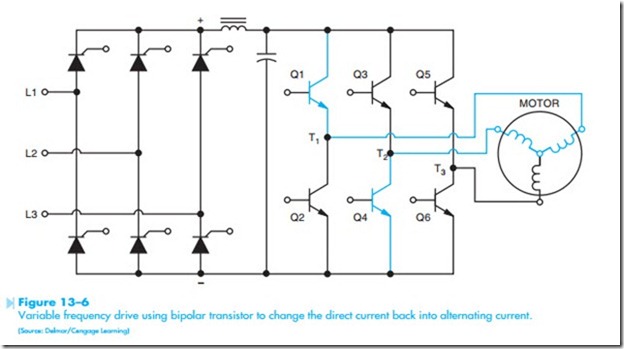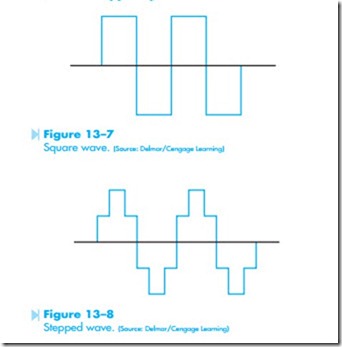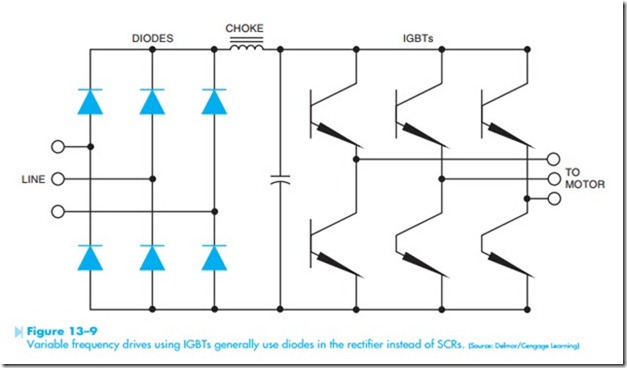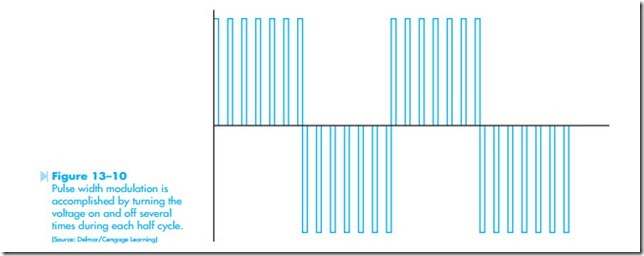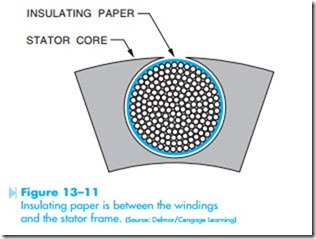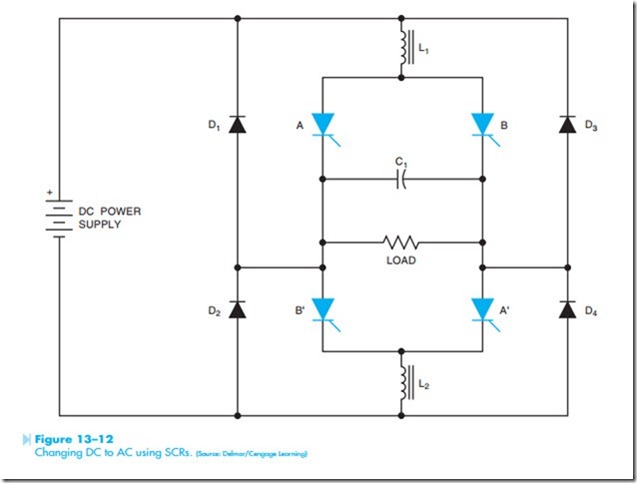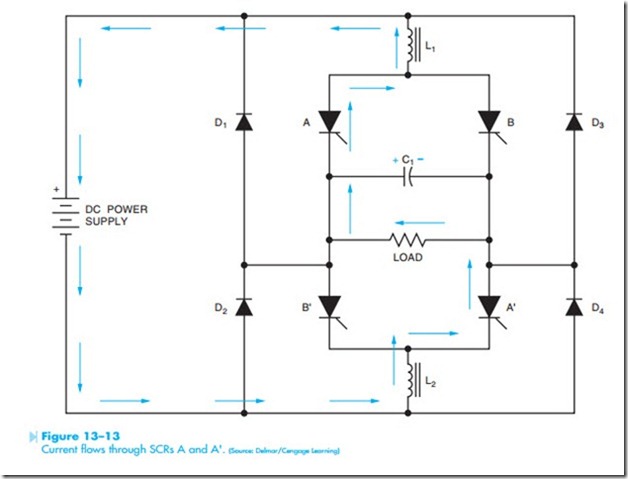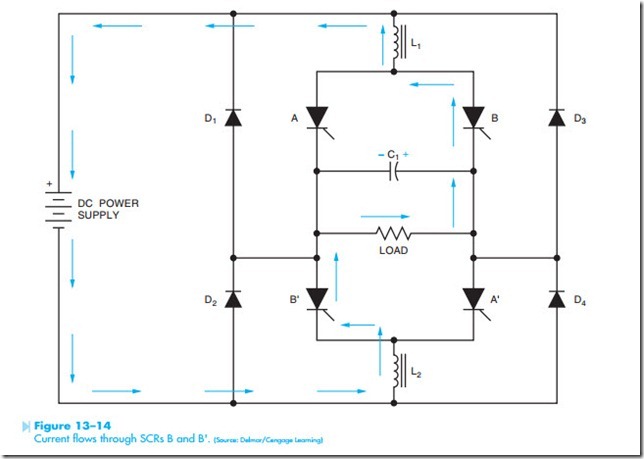VARIABLE FREQUENCY DRIVES
One of the factors that determines the speed of the rotating magnetic field of an AC induction motor is the frequency of the applied voltage. If the frequency is changed, the speed of the rotating magnetic field changes also. A four-pole stator will have a synchronous speed (speed of the rotating magnetic field) of 1,800 RPM when connected to a 60-Hz line. If the frequency is lowered to 30 Hz, the synchronous speed decreases to 900 RPM.
When the frequency is lowered, care must be taken not to damage the stator windings. The current flow through the winding is limited to a great extent by inductive reactance. When the frequency is lowered, inductive reactance is lowered also (XL = 2πFL). For this reason, variable frequency drives must employ some method of lowering the applied voltage to the stator as frequency is reduced.
In the air conditioning field, variable frequency drive is often used to control the speed of blower motors. This method of controlling air flow can be more efficient than inserting dampers into the duct system. Variable frequency drives are very popular in zone controlled systems.
Most variable frequency drives operate by first changing the AC voltage into DC and then changing it back to AC at the desired frequency. A variable frequency drive is shown in Figure 13–5. There are several methods used to change the DC voltage back into AC. The method employed is generally determined by the manufacturer, age of the equipment, and the size motor the drive must control. Variable frequency drives intended to control the speed of motors up to 500 horsepower generally use transistors. In the circuit shown in Figure 13–6, a three-phase bridge changes the three-phase alternating-current into direct current. The bridge rectifier uses SCRs (silicon controlled rectifiers) instead of diodes. The SCRs permit the output voltage of the rectifier to be controlled. As the frequency decreases, the SCRs fire later in the cycle and lower the output voltage to the transistors. A choke coil and capacitor bank are used to filter the output voltage before transistors Q1 through Q6 change the DC voltage back into AC. An electronic control unit is connected to the bases of transistor Q1 through Q6. The control
unit converts the DC voltage back into three-phase alternating current by turning transistors on or off at the proper time and in the proper sequence. Assume, for example, that transistors Q1 and Q4 are switched on at the same time. This permits stator winding T1 to be connected to a positive voltage and T2 to be connected to a negative voltage. Current can flow through Q4 to T2, through the motor stator winding and through T1 to Q1.
Now assume that transistors Q1 and Q4 are switched off and transistors Q3 and Q6 are switched on. Current will now flow through Q6 to stator winding T3, through the motor to T2, and through Q3 to the positive of the power supply.
Because the transistors are turned completely on or completely off, the waveform produced is a square wave instead of a sine wave, Figure 13–7. Induction motors will operate on a square wave
without much of a problem. Some manufacturers design units that will produce a stepped waveform as shown in Figure 13–8. The stepped waveform is used because it closely approximates a sine wave.
Some Related Problems
The circuit illustrated in Figure 13–6 employs the use of SCRs in the power supply and junction transistors in the output stage. SCR power supplies control the output voltage by chopping the incoming waveform. This can cause harmonics on the line that cause overheating of transformers and motors, and can cause fuses to blow and circuit breakers to trip. When bipolar junction transistors are employed as switches, they are generally driven into saturation by supplying them with an excessive amount of base-emitter current. Saturating the transistor causes the collector-emitter voltage to drop to between 0.04 and 0.03 volts. This small voltage drop allows the transistor to control large amounts of current without being destroyed. When a transistor is driven into saturation, however, it cannot recover or turn off as quickly as normal. This greatly limits the frequency response of the transistor.
IGBTs
Many transistor-controlled variable drives now employ a special type of transistor called an insulated gate bipolar transistor (IGBT). IGBTs have an insulated gate very similar to some types of field effect transistors (FETs). Because the gate is insulated, it has a very high impedance. The IGBT is a voltage controlled device, not a current controlled device. This gives it the ability to turn off very quickly. IGBTs can be driven into saturation to provide a very low voltage drop between emitter and collector, but they do not suffer from the slow recovery time of common junction transistors.
Drives using IGBTs generally use diodes to rectify the AC voltage into DC, not SCR, Figure 13–9. The three-phase rectifier supplies a constant DC volt- age to the transistors. The output voltage to the motor is controlled by pulse width modulation (PWM). PWM is accomplished by turning the transistor on and off several times during each half cycle, Figure 13–10. The output voltage is an average of the peak or maximum voltage and the amount of time the transistor is turned on or off. Assume that 480 volts 3 phase AC is rectified to DC and filtered. The DC voltage applied to the IGBTs is approximately 630 volts. The output voltage to the motor is controlled by the switching of the transistors. Assume that the transistor is on for 10 microseconds and off for 20 microseconds. In this example the transistor is on for one-third of the time and off for two-thirds of the time. The voltage applied to the motor would be 210 volts (630/3).
Advantages and Disadvantages of IGBT Drives
A great advantage of drives using IGBTs is the fact that SCRs are generally not used in the power supply and this greatly reduces problems with line harmonics. The greatest disadvantage is that the fast switching rate of the transistors can cause volt- age spikes in the range of 1,600 volts to be applied to the motor. These voltage spikes can destroy some motors. Line length from the drive to the motor is of great concern with drives using IGBTs. The shorter the line length the better.
Inverter Rated Motors
Because of the problem of excessive voltage spikes caused by IGBT drives, some manufacturers pro- duce a motor that is “inverter rated.” These motors are specifically designed to be operated by variable
frequency drives. They differ from standard motors in several ways:
1. Many inverter rated motors contain a separate blow to provide continuous cooling for the motor regardless of the speed. Many motors use a fan connected to the motor shaft to help draw air though the motor. When the motor speed is reduced, the fan cannot maintain sufficient air flow to cool the motor.
2. Inverter rated motors generally have insulating paper between the windings and the stator core, Figure 13–11. The high voltage spikes produce high currents that produce a high magnetic field. This increased magnetic field causes the motor windings to move. This movement can eventually cause the insulation to wear off the wire and produce a grounded motor winding.
3. Inverter rated motors generally have phase paper added to the terminal leads. Phase paper is insulating paper added to the terminal leads that exit the motor. The high voltage spikes affect the beginning lead of a coil much more than the wire inside the coil. The coil is an inductor that naturally opposes a change of current. Most of the insulation stress caused by high voltage spikes occurs at the beginning of a winding.
4. The magnet wire used in the construction of the motor windings has a higher rated insulation than other motors.
5. The case size is larger than most three phase motors. The case size is larger because of the added insulating paper between the windings and the stator core. Also, a larger case size helps cool the motor by providing a larger surface area for the dissipation of heat.
Variable Frequency Drives Using SCRs and GTOs
Variable frequency drives intended to control motors over 500 horsepower generally use SCRs or GTOs (gate turn off device). GTOs are similar to SCRs except that conduction through the GTO can be stopped by applying a negative voltage, negative with respect to the cathode, to the gate. SCRs and GTOs are thyristors and have the ability to handle a greater amount of current than transistors. An example of a single-phase circuit used to convert DC voltage to AC voltage with SCRs is shown in Figure 13–12. In this circuit, the SCRs are connected to a control unit which controls the sequence and rate at which the SCRs are gated on. The circuit is constructed so that SCRs A and A’ are gated on at the same time and SCRs B and B’ are gated on at the same time. Inductors L1 and L2 are used for filtering and wave shaping. Diodes D1 through D4 are clamping diodes and are used to prevent the output voltage from becoming excessive. Capacitor C1 is used to turn one set of SCRs off when the other set is gated on. This capacitor must be a true AC capacitor because it will be charged to the alternate polarity each half cycle. In a converter intended to handle large amounts of power, capacitor C1 will be a bank of capacitors. To understand the operation of the circuit, assume that SCRs A and A’ are gated on at the same time. Current will flow through the circuit as shown in Figure 13–13. Notice the direction of current flow through the load, and also that capacitor C1 has been charged to the polarity shown. When an SCR is gated on, it can only be turned off by permitting the current flow through the anode- cathode section to drop below a certain level called the holding current level. As long as the current continues to flow through the anode-cathode the SCR will not turn off.
Now assume that SCRs B and B’ are turned on. Because SCRs A and A’ are still turned on, two current paths now exist through the circuit. The positive charge on capacitor C1, however, causes the negative electrons to see an easier path. The current will rush to charge the capacitor to the opposite
polarity, stopping the current flowing through SCRs A and A’ permitting them to turn off. The current now flows through SCRs B and B’ and charges the capacitor to the opposite polarity, Figure 13–14. Notice that the current now flows through the load in the opposite direction, which produces alternat- ing current across the load.
To produce the next half cycle of AC current, SCRs A and A’ are gated on again. The positively charged side of the capacitor will now cause the current to stop flowing through SCRs B and B’ per- mitting them to turn off. The current again flows through the load in the direction indicated in Figure 13–14. The frequency of the circuit is deter- mined by the rate at which the SCRs are gated on.
FEATURES OF VARIABLE FREQUENCY CONTROL. Although the primary purpose of a variable frequency drive is to provide speed control for an AC motor, most drives provide functions that other types of controls do not. Many variable frequency drives can provide the low speed torque characteristic that is so desirable in DC motors. It is this feature that permits AC squirrel-cage motors to replace DC motors for many applications.
Many variable frequency drives also provide cur- rent limit and automatic speed regulation for the motor. Current limit is generally accomplished by connecting current transformers to the input of the drive and sensing the increase in current as load is added. Speed regulation is accomplished by sensing the speed of the motor and feeding this information back to the drive.
Another feature of variable frequency drives is acceleration and deceleration control, sometimes
called “ramping.” Ramping is used to accelerate or decelerate a motor over some period of time. Ramping permits the motor to bring the load up to speed slowly as opposed to simply connecting the motor directly to the line. Even if the speed control is set in the maximum position when the start button is pressed, ramping permits the motor to accelerate the load from zero to its maximum RPM over several seconds. This feature can be a real advantage for some types of loads, especially gear drive loads. In some units the amount of acceleration and deceleration time can be adjusted by setting potentiometers on the main control board. Other units are completely digitally controlled and the acceleration and deceleration times are programmed into the computer memory.
Some other adjustments that can usually be set by changing potentiometers or programming the unit are as follows:
Current Limit: These controls set the maxi- mum amount of current the drive is permitted to deliver to the motor.
Volts per Hertz: This sets the ratio by which the voltage increases as frequency increases or decreases as frequency decreases.
Maximum Hertz: These controls set the maximum speed of the motor.
Minimum Hertz: This sets the minimum speed the motor is permitted to run.

